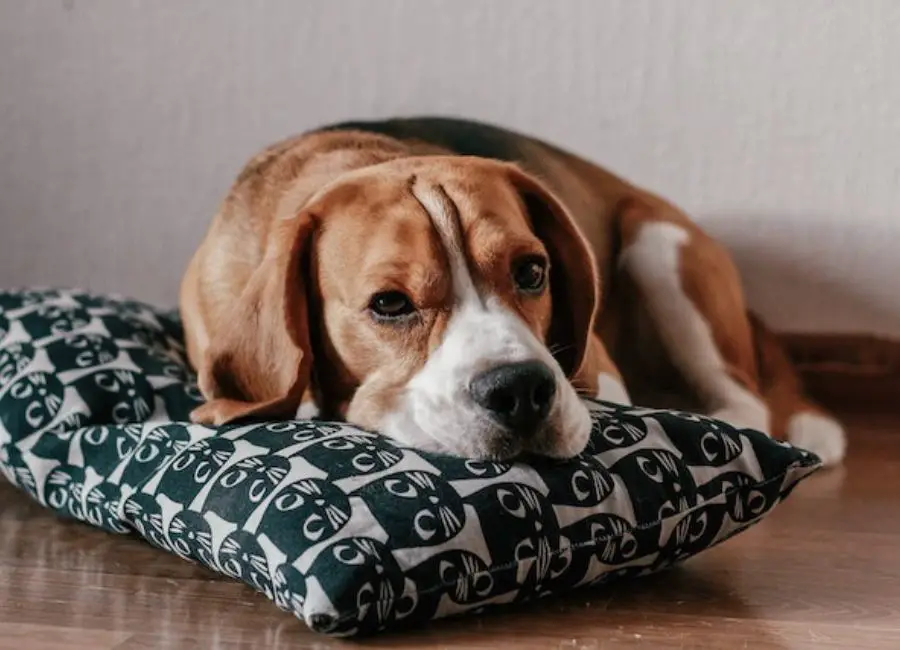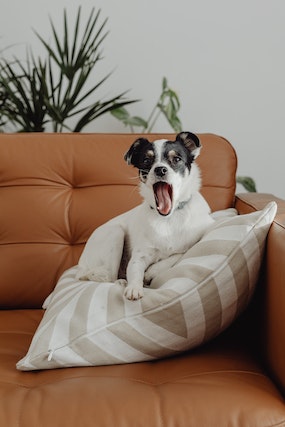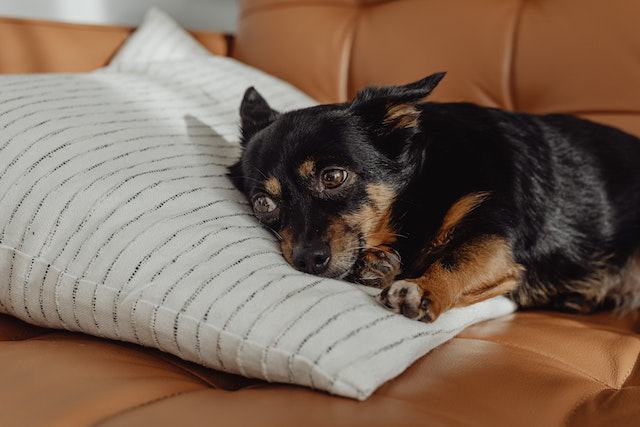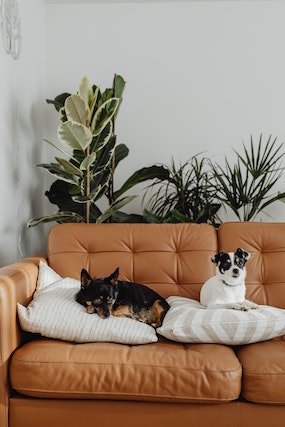10 Reasons Your Dog Licks Pillow & Fix Tips

Let’s dive into a curious canine behavior that has perplexed pet parents for ages – dog licks pillow.
We’ve all experienced that adorable moment when our furry friends get their tongues all over our comfy cushions, and we can’t help but wonder, “Why on earth are they doing that?”
Well, fret no more, because today, we’re going to unravel the mystery behind this amusing habit. So, grab a seat and get ready to uncover the secret behind the irresistible allure of pillow licking!
The Science Behind Dog-Licking Behavior
The Jacobson’s organ, also known as the vomeronasal organ, plays a crucial role in a dog’s licking behavior. Located on the roof of their mouth, this organ enables dogs to detect pheromones and other chemical signals.
Licking allows them to gather information about other animals, objects, and even humans, providing insights into their environment.
Moreover, licking triggers the release of endorphins in dogs, which are natural feel-good chemicals. It acts as a stress reliever and brings comfort, which explains why some dogs may lick excessively when they are anxious or nervous.
Why Your Dog Licks Pillow
Dogs may lick pillows for several reasons, as it could be a comforting behavior that mimics nursing from their mother as puppies, the pillow may have a scent or taste that the dog finds appealing.
Additionally, dogs may lick pillows as a form of self-soothing or to alleviate boredom or anxiety, it could simply be a habit that the dog has developed over time.
It’s important to monitor and redirect this behavior if it becomes excessive or problematic, if excessive licking occurs, it’s essential to monitor their behavior and consult a veterinarian if any health concerns arise.
Let’s dive deeper for a better understanding…
Reasons Why Dogs Lick Pillows

The following are some of the most common reasons why dogs lick pillows:
1. Exploration and Curiosity
Dogs are naturally inquisitive creatures, and licking pillows may be a way for them to gather information about their environment. Just like humans use their hands to touch and feel, dogs use their tongues.
To address this, provide your furry friend with ample opportunities for exploration, such as interactive toys, puzzle feeders, and different textures to investigate. Engaging your dog’s mind with new experiences can help satisfy their curiosity and reduce the desire to lick pillows.
2. Boredom
Like humans, dogs can become bored when they lack mental and physical stimulation. Licking pillows might be a way for them to pass the time. Combat boredom by incorporating regular exercise and play sessions into your dog’s daily routine.
Taking them for walks, engaging in interactive games, and teaching them new tricks can provide the mental and physical challenges they need to stay engaged and happy.
3. Attention-Seeking Behavior
Dogs are social animals and crave interaction with their human companions. If your dog licks pillows to get your attention, it’s essential to respond with positive reinforcement when they exhibit desirable behaviors.
Shower them with praise, treats, or affection when they engage in activities that you approve of. This way, they will learn that positive behaviors lead to rewards, and attention-seeking licking may diminish.
4. Pica Issue
Pica is a condition where dogs develop a craving for non-food items, like pillows. This behavior can result from nutritional deficiencies or behavioral issues.
If you suspect pica, consult with a veterinarian to rule out any underlying medical problems. Your vet can recommend appropriate dietary adjustments or supplements to address potential deficiencies and help curb the undesirable licking behavior.
5. Anxiety and Separation Anxiety
Dogs can experience anxiety, especially when left alone or faced with stressful situations. Licking pillows may serve as a coping mechanism during such times. To address anxiety-related licking, work on desensitization and counter-conditioning techniques.
Gradually expose your dog to the triggers that cause anxiety while providing positive experiences and rewards. Additionally, consider crate training or creating a safe space where your dog can feel secure when you’re not around.
6. Habitual Behavior
Over time, licking pillows can become a habit for some dogs. Breaking this habit requires consistent redirection and positive reinforcement.
Whenever you catch your dog about to lick a pillow, gently guide their attention to a more appropriate activity, like playing with a chew toy or interacting with you. Be patient, as breaking habits takes time and repetition.
7. Pheromone Communication
Dogs communicate through scent, and licking pillows can be a way for them to mark the territory as their own. Consistent obedience training is crucial in establishing boundaries for your dog.
Use positive reinforcement techniques to reinforce commands like “stay” and “leave it,” helping them understand where and when licking is appropriate.
8. Medical Issues
Excessive licking of pillows can sometimes be a symptom of underlying medical issues, such as allergies, skin irritations, or gastrointestinal problems.
If you notice other signs like redness, swelling, or persistent scratching, consult your veterinarian for a thorough examination and proper diagnosis.
9. Salt and Sweat Attraction
Dogs have a keen sense of taste, and they may be drawn to the salt left behind on pillows due to human sweat.
Ensure that your dog has access to clean, fresh water at all times to quench their thirst and reduce the likelihood of seeking salt elsewhere. This will also promote proper hydration, which is crucial for their overall health.
10. Comfort and Security
Dogs have a strong sense of smell, and pillows often carry the comforting scent of their owners or other family members. Licking pillows can be a self-soothing behavior that helps them feel more secure. To address this, focus on creating a safe and peaceful environment for your dog.
Providing a cozy and designated sleeping area can give them a sense of security. Additionally, you can introduce calming aids like lavender-scented sprays or pheromone diffusers to help relax your furry companion.
Potential Health Implications of Your Dog Pillow Licking

While pillow licking may seem harmless, it can have some health implications. One concern is the transmission of bacteria and germs from the dog’s mouth to the pillow, which could lead to infections or illnesses.
Additionally, some dogs may develop allergic reactions or skin irritations from contact with certain pillow materials or detergents.
Furthermore, frequent licking of hard surfaces, like the pillow, can lead to dental problems in dogs. It may cause wear and tear on their teeth, leading to dental discomfort or damage.
When to Be Concerned About Your Dog Pillow Licking
While occasional pillow licking is generally harmless, persistent and obsessive behavior might indicate an underlying issue.
If your dog’s licking becomes compulsive and disrupts their daily life, it’s best to seek advice from a veterinarian or a professional animal behaviorist. They can evaluate your dog’s behavior and recommend suitable interventions.
How to Manage Dog Pillow Licking Issue
If your dog has developed a habit of licking pillows excessively, it’s essential to address the behavior.
Positive reinforcement techniques can be helpful in redirecting their focus away from the pillows. Offering praise or treats when they refrain from licking can encourage good behavior.
Providing appropriate chewing toys can also give them an alternative outlet for their oral tendencies. Engaging them in playtime and other activities can help distract them from their pillow-licking habit.
Learn more about dog behavior problems.
How to Prevent Your Dog From Licking Pillows

To prevent your dog from licking pillows, you can try the following common methods:
- Provide appropriate chew toys: Dogs often lick or chew on pillows out of boredom or as a way to relieve anxiety. Providing your dog with a variety of appropriate chew toys can redirect their chewing behavior away from pillows.
- Use bitter sprays or deterrents: You can apply bitter-tasting sprays or use deterrent products on pillows to make them unappealing to your dog. The unpleasant taste or smell can discourage them from licking or chewing on the pillows.
- Train the “leave it” command: Teach your dog the “leave it” command and use it consistently whenever they show interest in the pillows. Reward them with treats or praise when they respond appropriately. This helps them understand that pillows are off-limits.
- Provide mental and physical stimulation: A bored or understimulated dog is more likely to engage in destructive behaviors, such as licking pillows. Make sure your dog gets plenty of physical exercise and mental stimulation through activities like walks, playtime, and puzzle toys.
- Create a designated resting area: Dogs often lick pillows that have their scent on them to comfort themselves. Create a designated resting area for your dog with their own bed or blanket that carries their scent. This can help redirect their licking behavior to their own belongings.
- Use positive reinforcement training: Reward your dog when they exhibit desired behaviors, such as lying quietly on their own bed or chewing toys. Positive reinforcement can help reinforce good behavior and discourage licking pillows.
- Address underlying medical issues: Excessive licking can sometimes indicate medical issues, such as allergies or skin irritations. If your dog’s pillow licking persists despite efforts to prevent it, consult with a veterinarian to rule out any underlying health problems.
- Provide a comfortable and relaxing environment: Ensure that your dog’s sleeping area is comfortable, clean, and free from any irritants that may trigger them to lick. Make sure they have access to fresh water and a calm environment that promotes relaxation.
- Supervise and redirect: Supervise your dog when they are near pillows, especially during training or when they are likely to engage in licking behavior. If you catch them licking the pillows, calmly redirect their attention to a more appropriate activity or chew toy.
Remember that each dog is unique, and what works for one may not work for another. It may take time and consistency to effectively prevent your dog from licking pillows.
If the problem persists or worsens, a professional dog trainer or behaviorist can provide personalized guidance
Learn more about your dog licking your face.
Related Questions
Why does my dog lick my pillow?
It’s not uncommon for dogs to lick pillows or other items. Licking can be a way for your dog to show affection, seek attention, or even soothe themselves. They might also be attracted to the smell or taste of your pillow, especially if it has your scent on it.
Is it safe for my dog to lick my pillow?
Generally, it’s safe for your dog to lick your pillow. However, if your dog has any open wounds, or infections, or is prone to allergies, it might be best to discourage them from licking your pillow to avoid any potential health issues.
Learn more about dealing with a dog with a smelling mouth.
How can I stop my dog from licking my pillow?
To discourage your dog from licking your pillow, you can try redirecting their attention to a chew toy or providing them with their own designated pillow or blanket. Consistently reinforcing positive behavior and providing alternative options can help break the habit.
Can my dog get sick from licking pillows?
In most cases, licking a pillow is unlikely to make your dog sick. However, if the pillow is dirty, has toxic substances on it, or if your dog has a weakened immune system, there is a slight risk of illness. Regularly washing and keeping your pillows clean can help minimize any potential health risks.
Learn more about your dog licking your hand.
My dog only licks one specific pillow, why?
Dogs can develop specific preferences for certain objects or scents. If your dog only licks one specific pillow, it could be due to the pillow’s texture, smell, or association with comfort. It could also be a behavior rooted in separation anxiety or stress.
Should I be concerned if my dog obsessively licks pillows?
If your dog’s licking behavior becomes excessive, compulsive, or starts causing harm to themselves or your home, it might be worth consulting with a veterinarian or animal behaviorist. They can help determine the underlying cause and provide guidance on how to manage or treat the behavior.
Learn more about your dog licking your mouth.
Conclusion
In conclusion, the furry little creatures we call dogs have a way of brightening our lives in the most unexpected ways. From their wagging tails to their playful antics, they bring joy and love into our homes. But let’s not forget about one peculiar behavior that never fails to make us chuckle – the infamous dog lick pillow phenomenon.
Whether it’s their way of claiming your beloved cushion as their own or a sign of pure affection, it’s undeniable that this adorable quirk adds a unique touch to our furry friendships. So next time you catch your pup in the act, remember to embrace the silliness and give them an extra scratch behind the ears. After all, life is just better with a little bit of doggy slobber!
